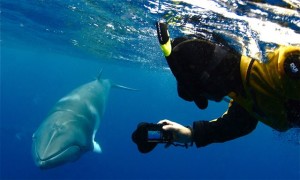 Minke Research & Interaction Procedures
Minke Research & Interaction Procedures
Before describing my experiences with the minke whales, I’d like to provide some basic information on minkes, research practices, and procedural aspects of dwarf minke whale interaction.
Eye-To-Eye Supports Research
Eye to Eye Marine Encounters provides ongoing support for numerous research endeavors on the GBR, including the Minke Whale Project. They offer free room & board for one or more researchers on all of their charters, enabling scientists to conduct studies, take photos & video footage, and gather other forms of data.
Passengers support the research efforts by funding the charters and by making an (optional) donation to the project. In turn, the researchers are available during the trips to provide insight & education about the species being studied.
During our first week, we had two researchers on-board, Drs. Alastair Birtles and Susan Sobtzick. Their work included ID-ing the whales via photos and video, counting how many times the minkes swam by the line, measuring their size, and recording their (categorized) behaviors.
The Whales Control the Encounter
The standard protocol for dwarf minke whale interaction on the GBR was created by the Minke Research Team and is enforced by the Australian government. This protocol enables the minkes to control the encounters; the whales decide if they want to approach us, and they determine the duration & intimacy of the interaction.
Extending an Open Heart
The plan is simple: when a minke demonstrates interest by swimming near or around the boat, the crew extends a current line from the stern of the boat. One or more people enter the water and hang on to the line, allowing the minkes to approach if they desire.
The crew can put out one or two current lines which may extend as far as 50+ ft from the boat. There are often knots or loops on the line enabling the snorkelers to hold their position as the whales engage.
Staying Connected!
This procedure works really well for both the whales and the snorkelers, because the whales know where to find us, and we don’t get spread out on the surface of the ocean and swept away by currents. Sometimes the boat is moored on a site, and other times the boat is adrift in the open sea, so it’s important for snorkelers to stay on the line!
While it may be tempting to swim off with a friendly whale, in doing so a snorkeler will inevitably swim the whale away from everyone else. In addition, the swimmer can easily end up too far to safely return to the boat.
It Works!
When I first followed this protocol with the minkes, I was circumspect about the quality of the encounter. The line felt intuitively restrictive, especially since the dwarf minkes are an ‘active’ species of whales. They like to keep moving, unlike humpbacks who will sometimes settle languorously in a general vicinity for hours at a time singing, sleeping, etc.
Fortunately, the moment I jumped in the water and grabbed hold of the line, it was abundantly clear that these sweet and curious whales love seeking out people who are hanging on a line! In fact, dwarf minkes swarm to people along the line like bees to honey!
